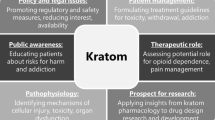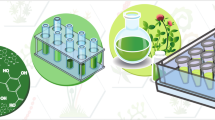Abstract
Es kann die Spur von unseren Erdetagen is a slightly modified line from Goethe’s tragedy Faust and together with the following line can be translated as “The vestiges of our path on earth/Through aeons cannot fade away”. The author’s festival speech at the 50th Spring Meeting of the German Pharmacological Society this year in Mainz was given under that title and is presented here in abridged form. Twelve examples are given showing that indeed our, the pharmacologists’, professional vestiges cannot disappear. Many pharmacologists may share this view of their profession.








Similar content being viewed by others
References
Chang MM, Leeman SE, Niall HD (1971) Amino-acid sequence of substance P. Nat New Biol 232:86–87
Donnerer J, Lembeck F (2006) The chemical languages of the nervous system. Karger, Basel
Eichelbaum M, Schwab M (2009) Wirkungen des Organismus auf Pharmaka: allgemeine Pharmakokinetik. In: Aktories K, Förstermann U, Hofmann F, Starke K (eds) Allgemeine und spezielle Pharmakologie und Toxikologie, 10th edn. Urban & Fischer, München, pp 36–64
Eichelbaum M, Spannbrucker N, Dengler HJ (1975) N-Oxidation of sparteine in man and its interindividual differences. Naunyn Schmiedebergs Arch Pharmacol 287:R94
Eichelbaum M, Spannbrucker N, Steincke B, Dengler HJ (1979) Defective N-Oxidation of sparteine in man: a new pharmacogenetic defect. Eur J Clin Pharmacol 16:183–187
Faust ES (1900) Ueber die Ursachen der Gewöhnung an Morphin. Arch Exp Pathol Pharmakol 44:217–238
Gilsbach R, Hein L (2008) Presynaptic metabotropic receptors for acetylcholine and adrenaline/noradrenaline. In: Südhof TC, Starke K (eds) Pharmacology of neurotransmitter release. Handbook of experimental pharmacology, vol 184. Springer, Berlin, pp 261–288
Habermann E, Dreyer F, Bigalke H (1980) Tetanus toxin blocks the neuromuscular transmission in vitro like botulinum A toxin. Naunyn Schmiedebergs Arch Pharmacol 311:33–40
Haycraft JB (1884) Ueber die Einwirkung eines Secretes des officinellen Blutegels auf die Gerinnbarkeit des Blutes. Arch Exp Pathol Pharmakol 18:209–217
Hertting G, Schiefthaler T (1963) Beziehung zwischen Durchflußgröße und Noradrenalinfreisetzung bei Nervenreizung der isoliert durchströmten Katzenmilz. Naunyn-Schmiedebergs Arch Exp Pathol Pharmakol 246:13–14
Jacobj C (1904) Ueber Hirudin. Dtsch Med Wochenschr 30:1786–1787
Jakobs KH, Saur W, Schultz G (1978) Inhibition of platelet adenylate cyclase by epinephrine requires GTP. FEBS Lett 85:167–170
Jakobs KH, Aktories K, Schultz G (1979) GTP-dependent inhibition of cardiac adenylate cyclase by muscarinic cholinergic agonists. Naunyn Schmiedebergs Arch Pharmacol 310:113–119
Klavdieva MM (1996) The history of neuropeptides. Front Neuroendocrinol 17:126–153
Leeman SE, Mroz EA (1974) Substance P. Life Sci 15:2033–2044
Lembeck F, Starke K (1968) Substanz P und Speichelsekretion. Naunyn-Schmiedebergs Arch Pharmakol Exp Pathol 259:375–385
Lindner E, Dohadwalla AN, Bhattacharya BK (1978) Positive inotropic and blood pressure lowering activity of a diterpene derivative isolated from Coleus forskohlii: forskolin. Arzneim Forsch 28:284–289
Löffelholz K, Muscholl E (1969) A muscarinic inhibition of the noradrenaline release evoked by postganglionic sympathetic nerve stimulation. Naunyn-Schmiedebergs Arch Pharmakol 265:1–15
Löffelholz K, Muscholl E (1970) Inhibition by parasympathetic nerve stimulation of the release of the adrenergic transmitter. Naunyn-Schmiedebergs Arch Pharmakol 267:181–184
Lüllmann H, Mohr K, Hein L (2006) Pharmakologie und Toxikologie, 16th edn. Thieme, Stuttgart
Markwardt F (1956) Untersuchungen über den Mechanismus der blutgerinnungshemmenden Wirkung des Hirudins. Naunyn-Schmiedebergs Arch Exp Pathol Pharmakol 229:389–399
Metzger H, Lindner E (1981) The positive inotropic-acting forskolin, a potent adenylatecyclase activator. Arzneim Forsch 31:1248–1250
Nowak G, Schrör K (2007) Hirudin—the long and stony way from an anticoagulant peptide in the saliva of medicinal leech to a recombinant drug and beyond. Thromb Haemost 98:116–119
Otsuka M, Yoshioka K (1993) Transmitter functions of tachykinins. Physiol Rev 73:229–308
Remmer H (1972) Induction of drug metabolizing enzyme system in the liver. Eur J Clin Pharmacol 5:116–136
Remmer H, Merker HJ (1963) Enzyminduktion und Vermehrung von endoplasmatischem Reticulum in der Leberzelle während der Behandlung mit Phenobarbital (Luminal). Klin Wochenschr 41:276–283
Remmer H, Siegert M, Merker HJ (1963) Beschleunigung des Arzneimittelstoffwechsels durch Enzyminduktion. Naunyn-Schmiedebergs Arch Exp Pathol Pharmakol 246:58–59
Repke K, Klesczewski S, Roth L (1959) Über Spaltung und Hydroxylierung von Digitoxin bei der Ratte. Naunyn-Schmiedebergs Arch Exp Pathol Pharmakol 237:34–48
Rossetto O, Montecucco C (2008) Presynaptic neurotoxins with enzymatic activities. In: Südhof TC, Starke K (eds) Pharmacology of neurotransmitter release. Handbook of experimental pharmacology, vol 184. Springer, Berlin, pp 129–170
Sanders D, Habermann E (1992) Evidence for a link between specific proteolysis and inhibition of [3H]-noradrenaline release by the light chain of tetanus toxin. Naunyn Schmiedebergs Arch Pharmacol 346:358–361
Starke K (2009) Pharmakologie noradrenerger und adrenerger Systeme. In: Aktories K, Förstermann U, Hofmann F, Starke K (eds) Allgemeine und spezielle Pharmakologie und Toxikologie, 10th edn. Urban & Fischer, München, pp 161–199
Starling EH (1907) Die chemische Koordination der Körpertätigkeiten. Verhandlungen der Gesellschaft deutscher Naturforscher und Ärzte, 78. Versammlung. Vogel, Leipzig, pp 246–260
Ther L, Muschaweck R, Hergott J (1957) Antagonismus zwischen Adenosin und Methyl-Xanthinen am Reizleitungssystem des Herzens. Naunyn-Schmiedebergs Arch Exp Pathol Pharmakol 231:586–590
Trendelenburg U (1960) The action of histamine and 5-hydroxytryptamine on isolated mammalian atria. J Pharmacol Exp Ther 130:450–460
Trendelenburg AU, Meyer A, Wess J, Starke K (2005) Distinct mixtures of muscarinic receptor subtypes mediate inhibition of noradrenaline release in different mouse peripheral tissues, as studied with receptor knockout mice. Br J Pharmacol 145:1153–1159
Wallis RB (1988) Hirudins and the role of thrombin: lessons from leeches. TIPS 9:425–427
Author information
Authors and Affiliations
Corresponding author
Rights and permissions
About this article
Cite this article
Starke, K. Es kann die Spur von unseren Erdetagen—on pharmacologists and pharmacology. Naunyn-Schmied Arch Pharmacol 380, 465–471 (2009). https://doi.org/10.1007/s00210-009-0443-7
Received:
Accepted:
Published:
Issue Date:
DOI: https://doi.org/10.1007/s00210-009-0443-7




